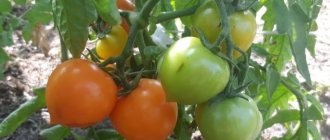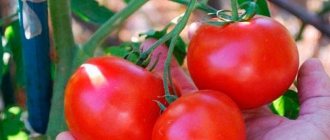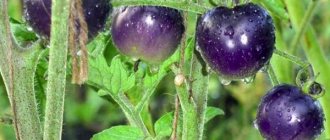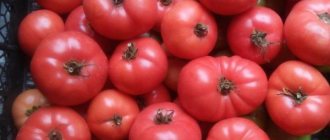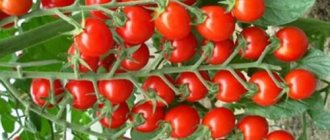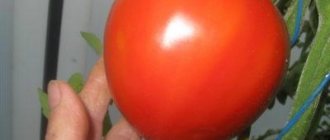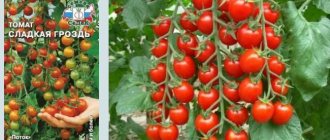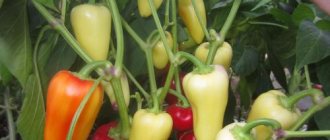» Vegetable growing » Tomatoes » Growing tomato Miracle bunch
0
2313
Article rating
Cherry is one of the most popular types of tomatoes. Tomato Miracle bunch is the most common variety among them. It appeared in the State Register in 2012.
- Characteristic
- Productivity
- Advantages and disadvantages
- Features of cultivation
- Sowing seeds for seedlings
- Transplanting seedlings
- Care
- Feeding
- Watering
- Reviews from gardeners
Growing tomato Miracle bunch
Description and characteristics of the variety
Cherry tomato Miracle bunch f1 is a hybrid bred relatively recently.
It was included in the State Register in 2012. It is recommended to be grown in open ground; it tolerates weather vagaries, cold snaps and drought well. But when planted in a greenhouse, it also develops well. Characteristics of tomato bushes: they are indeterminate and do not self-grow; they require formation. The height reaches 1.7-1.9 m. There are few leaves. The inflorescences are complex, they develop many ovaries that form large clusters of tomatoes. Description of the fruits: ripen 90-95 days after the seeds hatch. Tomatoes weigh 10-20 g, are round, bright red. The pulp is juicy, sweet, and usually has no sourness. You can eat tomatoes fresh, can them individually or on bunches, decorate and include in dishes. It is necessary to harvest frequently, as overripe tomatoes fall off the trusses.
Beneficial features
Miracle bunch tomatoes are harvested at the stage of technical ripeness. Green fruits set aside for ripening will not have the characteristic taste. After the onset of biological ripeness, tomatoes fall off the branches, and an overripe crop is prone to cracking. Transportation is carried out by placing the tomatoes in plastic containers, carefully closing them with a lid.
The pulp of the fruit contains:
- vitamins of groups: A, B, C, D, E, K, provitamin A;
- essential and fatty (25%) oil;
- substances: tannin, rutin;
- organic acids and mineral salts;
- a set of micro- and macroelements.
Miracle bunch tomatoes grown in open ground have the best taste. The hybrid is resistant to temperature changes and environmental influences. In cooking, miniature tomatoes serve as an excellent table decoration.
Landing
Plant seeds for seedlings in March. When planted in the ground, the age of the bushes should be 55-65 days. Overgrown seedlings take root worse, and the plants are not as productive.
Before sowing, prepare the seeds and soil:
- Mix 1 part of peat, humus and garden soil, add 1 or 0.5 parts of sand, as well as 1-2 cups of wood ash and 1-2 tablespoons of superphosphate per bucket of the mixture;
- The finished substrate is disinfected in one of the following ways: frozen outside or in a freezer, calcined in an oven at +110 degrees, poured with boiling water or a hot solution of potassium permanganate or copper sulfate;
- Treat containers for planting with a disinfectant composition;
- Hybrid seeds do not require treatment, but just in case, you can disinfect them with potassium permanganate and soak them in a stimulant solution.
In boxes with soil, grooves are made 1-2 cm deep, seeds are sown, and covered with soil. Water by spraying from a spray bottle. Then the glass-covered boxes are placed in a warm, well-lit place at +25 degrees. Sprouts appear after 5 days or a little later. When more than half of the seeds have sprouted, reduce the temperature and remove the film.
To prevent the bushes from becoming thin and stretched, they are kept at a temperature of +16 for the first three days. Then it is raised to +18-22.
You can feed the seedlings 1 or 2 times. In the phase of 2-3 leaves, seedlings dive. 3-4 bushes per 1 sq.m. are placed in a permanent place.
Reviews from gardeners
Recently, the Miracle bunch variety has been in relatively great demand among gardeners. All thanks to the plant’s unpretentiousness in cultivation and the taste characteristics of the fruit. Such tomatoes are convenient to use for preservation; they have a large number of useful substances.
The variety has high yields. The bushes bear fruit before the onset of cold weather and are highly resistant to different climatic conditions and diseases. The main thing is to grow them in well-lit areas. In the presence of darkening, the quality of the crop can be significantly reduced.
Growing and care
The tomato requires formation during the growing process. It must be kept in one stem and regularly pruned. When the top reaches the edge of the trellis, it is pinched. The stem is tied to a support.
Water weekly or twice a week, depending on the weather. Watering should be plentiful, but if water stagnates in the soil, it should be reduced. In hot weather, on the contrary, they increase it. Water in the morning or evening.
It is necessary to slightly heat the water, otherwise the tomatoes may lose their ovaries.
Feed 3-4 times:
- A week after rooting, add a solution of mullein 1:10;
- During flowering, water with a solution of superphosphate with potassium sulfate and the addition of mullein;
- For ripening, superphosphate is added or sprayed with a solution of boric acid.
What fruits grow on the Miracle Bunch?
The name of the variety was given by the peculiarity of fruiting: small spherical fruits (up to 20 g) are collected in beautiful, complex, branched clusters. Each bunch can consist of 50-60 tomatoes, and its total weight reaches 1 kg. The color of ripe fruits is deep red; they ripen simultaneously throughout the entire bunch, allowing the gardener to immediately harvest a significant amount of tomatoes.
See also
Description of the Russian Bogatyr tomato, its characteristics and cultivation techniques
Read
The skin is very durable. Mini tomatoes do not crack even under unfavorable conditions and remain fresh for a long time at room temperature. They are well transported and are quite capable of withstanding transportation from a summer cottage to the city.
The pulp has a rich red color. In greenhouse conditions, seeds sometimes do not set. Ripe tomatoes have a rich sweet taste and characteristic aroma. When picking unripe fruits, some of the taste benefits are lost.
The purpose of Miracle Bunch tomatoes is universal. From small tomatoes you can prepare very tasty and beautiful salads, use them to decorate dishes and sandwiches, and use them in gourmet snacks. Miniature sweet tomatoes are often called cocktail tomatoes, which emphasizes their use for decorating drinks.
Small tomatoes can be harvested for future use. Whole-fruit assorted preserves, including small vegetables of different types, look elegant and impressive. To make juices, you will have to collect a large number of these tomatoes, so processing them is not practiced. But the taste of this product is quite high. Small fruits are convenient to dry or freeze for use in winter.
Advantages and disadvantages
Since its appearance on the market, the tomato has quickly won fans because it has many advantages:
- The hybrid is protected from many diseases.
- The crop does not stop forming fruits in the absence of light, infrequent watering, or sudden cold weather.
- With a small weight of tomatoes, the plant shows good yield.
- Tomatoes look impressive when canned and can decorate salads made from fresh vegetables.
- The harvest does not deteriorate due to uncomfortable transportation.
- Ripe fruits have significant shelf life.
- In areas with short summers, the tomato has time to fully ripen.
Cherry care
In the middle zone, as well as in the regions of the Urals, Siberia, and the North-West, where summer is not long and has high temperatures, cherry tomatoes are grown in greenhouses.
Planting is carried out in May, when the soil warms up to +14ºC. Planting on ridges is possible, but in this case it will be necessary to provide temporary shelters, as well as consider supports for tall bushes. In greenhouses, racks for trellises are installed in advance, wire or ropes are pulled.
Planting scheme for the hybrid Miracle bunch - 3 plants per square meter. Typically, such tomatoes are not grown in large quantities, preferring ordinary tomatoes and considering cherry tomatoes to be fun and a variety for children. Three or four bushes in a greenhouse will be enough to taste and evaluate the taste of these “crumbs”.
Care includes:
- watering;
- fertilizing (productive cherry tomatoes require good nutrition);
- bush formation;
- regular stepsoning.
- prevention from diseases and pests.
Cherries need proper watering, since if there is a lack of moisture, the fruits will not be so juicy, and if there is too much moisture, they will be watery. The hybrid shows good yield when using drip irrigation systems, but if this is not possible, you just need to organize regular watering.
Fertilizing begins 18-20 days after planting, using organic matter and mineral fertilizers. Tomatoes need nitrogen in the first half of the growing season, and potassium and phosphorus during flowering, fruit set and ripening. It is convenient to use ready-made formulations - the already known Kemira, Effecton, Ideal, Agricola, which contain the nutrients necessary for tomatoes in exact proportions.
ON A NOTE! If the dose of nitrogen is exceeded, cherry bushes can “fatten”, intensively increasing their green mass. To correct the situation, exclude organic matter and spray the leaves with superphosphate extract.
It is advisable to combine watering in the greenhouse with fertilizing, after which it is necessary to ventilate the shelters.
Growing cherry tomatoes at home
At the end of the gardening season, mini-tomato lovers start sowing again and get a good harvest of cherry tomatoes right on the window of their house or apartment. Usually, determinant varieties are selected for home planting.
In order to get a cherry harvest at home, I soak the seeds for 6 hours in Epin’s solution, and then leave them on a wet sponge for another day or two. This provides constant moisture for the germinating seeds, without them getting wet or moldy.
To prevent the cherry tomato seeds from drying out in the sponge, make a small cut into which the seeds are inserted
I place the pots with seeds, covered with glass or film (which is less preferable, since fungus can become active in the ground), in a dark place for 2–4 days. On the 5th–6th day, I return the crops to the windowsill, preferably a south-eastern one, since future seedlings require diffused sunlight. From the moment the first shoots appear, I care for young plants in the same way as for ordinary tomatoes - watering, loosening, fertilizing.
When the third and fourth leaves grow, I carry out a dive. As soon as the cherry tomatoes gain color, I feed them with Bud or Ovary (according to the instructions). To help tomatoes set fruit, I recommend walking over the flowers with a brush or a soft bird feather, thereby transferring pollen from one plant to another.
In winter, tomatoes require mandatory lighting (daylight should be at least 12–14 hours).
To prevent seedlings and adult plants from stretching out in winter, supplementary illumination with special phytolamps is used.
As a result of the efforts made, you will be able to enjoy delicious mini-tomatoes all winter.
Features of agricultural technology
Tomato Miracle bunch F1 is grown without seedlings only by farmers from the southern regions. In other areas, preliminary preparation of seedlings is necessary. Agrotechnical recommendations for the hybrid:
- seeds are sown in early March;
- It is necessary to pick seedlings after the appearance of 2 leaves;
- the tomato is moved into the ground when the seedlings reach the age of 2 months;
- bush planting density – 3 pcs. per 1 m2;
- the plants are tied up and pinched in such a way that 2 long strong stems with bunches of tomatoes are formed;
- in the last days of summer, the top part of the crop is pinched;
- water the tomato every 3 to 4 days;
- The optimal number of feedings is 3.
